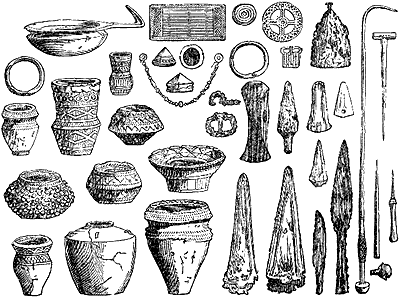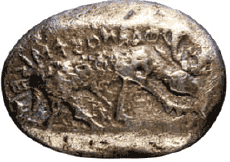
 History History |
Geography and Indian History  |
||||
| Reconstructing the Past | Ancient River Civilisations |
Reconstructing the Past
The process of peeping into the past to deduce mankind's social, cultural, economical and technological progress through time is an extremely difficult and arduous process at best. Historians have a number of methodologies and tools to help them reconstruct the past.
Geography & History
The geography of a region plays a major role in influencing its history. Geography gives the broad context on which to base an understanding of the pattern of historical progress of the human society in that region. Knowledge of geography of a region helps give a proper perspective to the study and analysis of past events.
Historical Sources
Historical sources are the sum total of all evidence left behind by past human society which help in reconstructing history. For studying the details of past cultures, historians depend a lot upon historical sources to tease information out of them. There are two major categories of historical sources – literary and archaeological.
Literary sources
Literary sources consist of all writings of the past which can help piece together the political, economic, social and cultural dimensions of those times. They are categorised into
- historical literature,
- religious texts,
- secular (non-religious) texts, and
- foreign accounts.
Literary sources can be in two forms: as manuscripts or as textual literature.
A manuscript is an ancient handwritten book or document, written on parchment, papyrus, palm leaves or on bark from trees like the birch, which has survived through the ages.
Historical Literature
Historical literature can be classified into (a) historical works and (b) biographies.
Historical works are those which have recorded the political, economic, social and cultural attainment of the human society. Biographies honour the life and achievements of rulers, and are often partisan.
Religious Texts
Religious texts deal with religion, religious codes of conduct and mythology.
Secular (Non-religious) Texts
Secular texts describe the political, economic, social and cultural life of those times. They also include treatises on the arts and the sciences.
Foreign Accounts
Foreign accounts comprise writings by foreign authors and travelers on the region under historical study.
Archaeological sources

Archaeological sources comprise material remains (artifactsAn artifact is a historically important object made by human hand a long time ago.), bones, old ruins and monuments of past human societies and activities. The artifacts may be in the form of tools, pottery, coins, sculpture and carvings.
Archaeology is the scientific study of these remains of the past societies, and those who study archaeology are known as archaeologists. Archaeologists research the remains to determine the time period of the past society, as well as to reconstruct their way of life..
Archaeological sources are categorised into
- archaeological sites & archaeological digs
- inscriptions, and
- coins.
Archaeological sites & Archaeological digs

Archaeological sites are areas being studied by archaeologists which show evidence of past human settlements and activities. These sites typically have old ruins, monuments and artifacts. Archaeological digs are archaeological sites excavated by archaeologists to reveal buried ruins, bones and artifacts which had been covered by earth with the passage of time.
Inscriptions
Inscriptions are writings engraved in historical artifacts of permanent nature like stones and metal plates. The study of inscriptions is called Epigraphy.
Inscriptions are generally of three types:
- commemorative inscriptions, bearing witness to certain special events, normally incised on stone;
- dedicatory inscriptions recording dedications of a monument, building, sculpture or image, normally incised on stone;
- donative inscriptions bearing witness to grants, normally engraved on copper plates.
Inscription are considered reliable because of they are available in the original form, as compared to information from literary sources, most of which are copies of the original and so might have been changed or modified. Inscriptions which contain dates help determine the time line of events and periods of rule of monarchs. The geographical spread of their discovery assist historians in resolving the extent and influence of kingdoms or religions.

Coins
Numismatics is the study of historical coins. It helps to determine the territorial extent of past ruling powers, their periods of rule, and their chronology. The symbols, figures and legends on the coins throw light on the administration in the region. The number of coins and the metals used to mint them (gold, silver, copper etc.) also give an idea of the prevailing economic conditions.
Dating of Artifacts
The first order of business after securing the material remains is to date them. Some artifacts, like coins, are self-dating, while others might have references in written records. Still others can be dated using relative dating and cross dating principles.
Radio-carbon dating
The radio-carbon dating technique is used for dating those remains which are associated with organic life. Plants absorb, and maintain, a certain level of radioactive carbon (C-14) from the atmosphere. C-14 is passed into animals as they feed off plants and other animals. When an organism dies, the C-14 keeps on decaying radioactively without being replenished. Since the rate of decay of C-14 is known, measuring the remaining quantity can help date organic remains.
However, radio-carbon dating is only accurate for artifacts less than 50,000 years old.
Other dating techniques
Thermoluminescence dating is used for inorganic material that have been baked, such as pottery and terracottaTerracotta refers to unglazed objects made by baking brown-red porous clay.. This method of dating can be precise up to 200,000 years ago.
Potassium-Argon dating is used for volcanic rocks, while electron spin resonance dating is employed for dating bones and shells.
List of References
Bibliography
| Reconstructing the Past | Ancient River Civilisations | ||||
 History History |
Geography and Indian History  |
 High School
High School Mathematics
Mathematics Sets & Basic Operations
Sets & Basic Operations